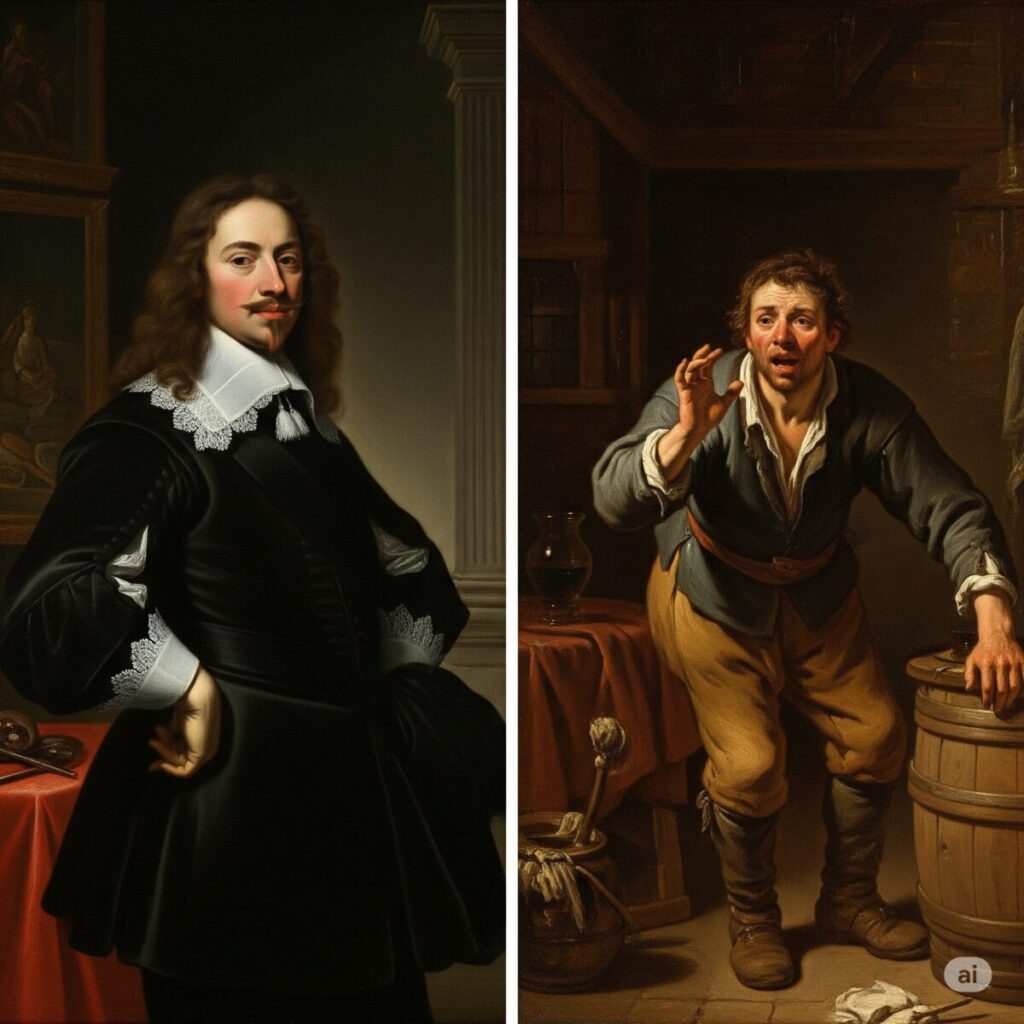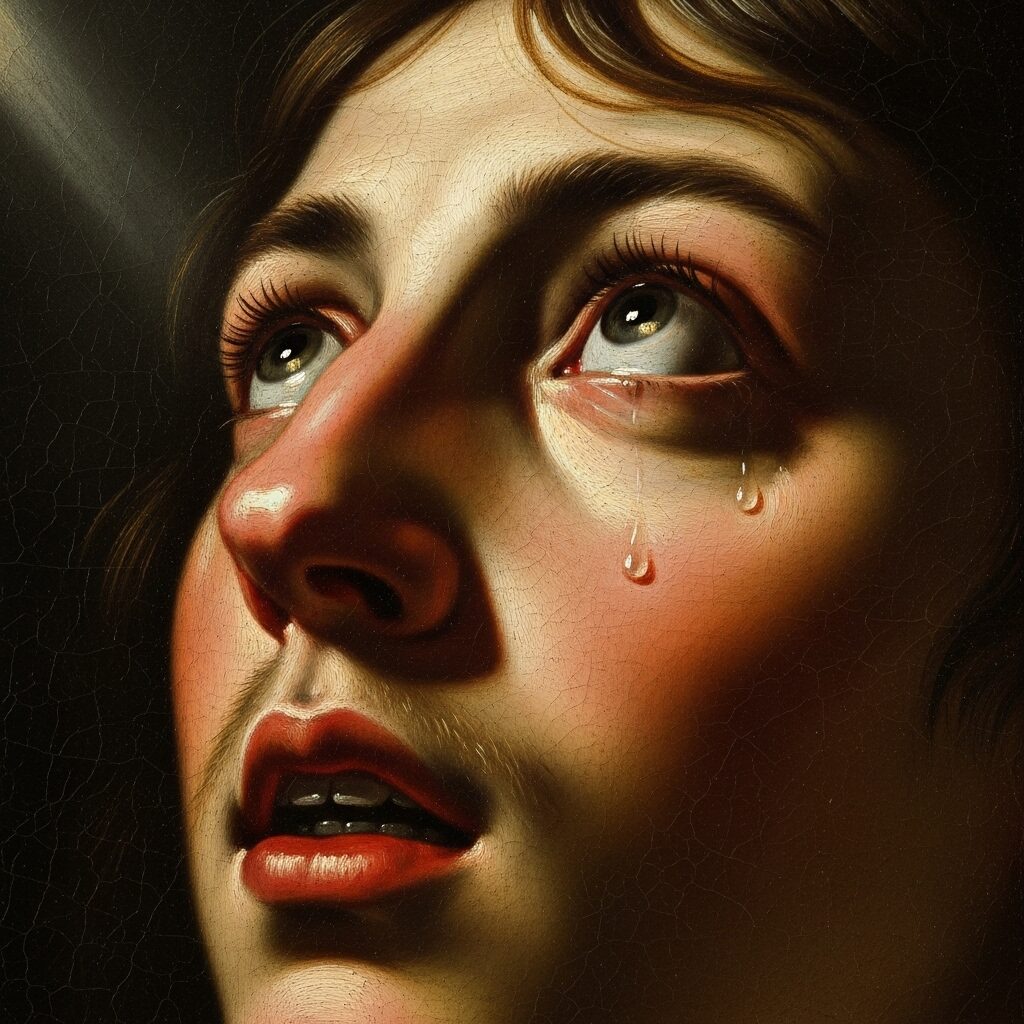
What is Tenebrism? Picture yourself walking through a dimly lit room when suddenly, a beam of light cuts through the darkness, revealing a scene so dramatic it takes your breath away. This is the magic of Tenebrism, a revolutionary painting technique that transformed how artists tell stories through light and shadow. More than just a style, Tenebrism became a powerful tool that helped painters create some of the most emotionally gripping artwork in history, using darkness as their stage and light as their spotlight.
Key Points Summary
- Definition: Tenebrism is an extreme form of chiaroscuro that uses dramatic contrasts between light and dark, with darkness dominating most of the canvas
- Origin: Developed by Italian master Caravaggio in the late 16th century during the Baroque period
- Purpose: Creates intense drama, emotional impact, and theatrical effects in paintings
- Key Difference: Unlike regular chiaroscuro, Tenebrism uses harsh, spotlight-like illumination against deep black backgrounds
- Famous Artists: Caravaggio, Artemisia Gentileschi, Georges de La Tour, and Jusepe de Ribera
- Legacy: Influenced countless artists including Rembrandt and continues to impact visual storytelling today
The Birth of Tenebrism: Caravaggio’s Revolutionary Technique
Tenebrism, from the Italian word “tenebroso” meaning dark or gloomy, emerged as a dramatic illumination technique that uses extreme contrasts of light and dark to heighten emotional impact. This groundbreaking approach was pioneered by Michelangelo Merisi da Caravaggio in Rome around 1600, during a time when art was becoming more emotional and realistic.
Before Caravaggio, most Renaissance painters used gentle, even lighting that showed every detail clearly. But Caravaggio had a different vision. He wanted his paintings to feel like moments frozen in time – urgent, dramatic, and intensely human. His facility with tenebrism was matched by his observational naturalism, which allowed for heightened intellectual and emotional engagement with contemporary viewers.
The technique got its name from the Latin word “tenebrae,” meaning darkness. But don’t think of this darkness as simply black paint – it’s an active part of the composition that creates mystery, builds tension, and makes the illuminated areas pop with incredible intensity.
“Tenebrism is used only to obtain a dramatic impact while chiaroscuro is a broader term, also covering the use of less extreme contrasts of light to enhance the illusion of three-dimensionality”
Art historians’ definition
Understanding Tenebrism: More Than Just Light and Dark
Where chiaroscuro is used to create a sense of depth, three-dimensionality, and realistic texture, tenebrism involves using the stark contrast of light and dark for dramatic effect in a composition. Think of it as the difference between a gentle sunrise and a lightning bolt – both involve light, but the impact is completely different.
The main characteristics of tenebrism include:
Dominant Darkness: Large portions of the canvas are painted in deep blacks or dark browns, creating a sense of mystery and focusing attention on the lit areas.
Spotlight Effect: Tenebrism is a lighting style in art, film and photography that’s defined by expressive contrast between light and dark. The light appears to come from a single, often unseen source, hitting subjects like a theatrical spotlight.
Emotional Intensity: The dramatic lighting creates psychological tension and makes viewers feel like they’re witnessing something important or secret.
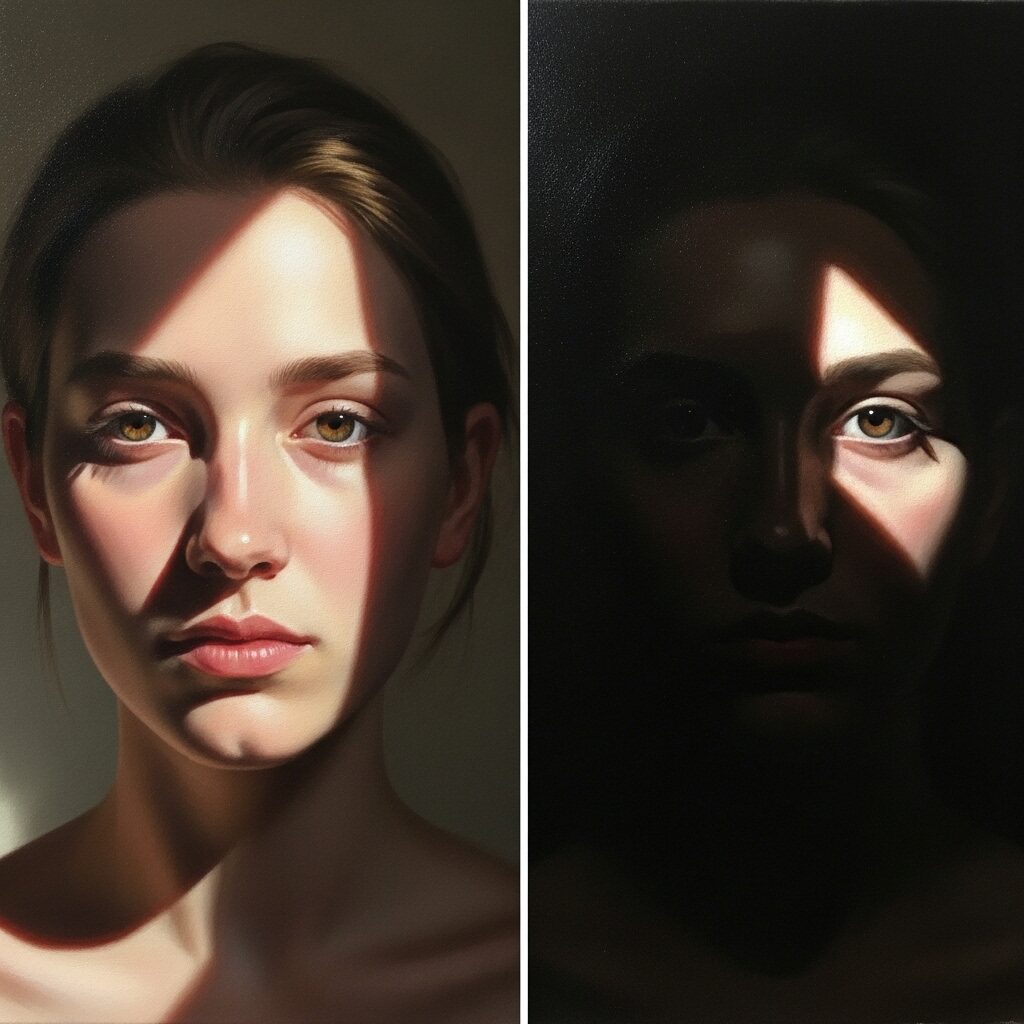
Selective Illumination: Only the most crucial parts of the scene are lit, eliminating distracting details and forcing viewers to focus on the story’s key elements.
Tenebrism vs. Chiaroscuro: Understanding the Difference
Many people confuse these two techniques, but understanding their differences helps us appreciate why tenebrism was so revolutionary:
| Aspect | Chiaroscuro | Tenebrism |
|---|---|---|
| Purpose | Creates realistic form and depth | Creates drama and emotional impact |
| Light Quality | Soft, gradual transitions | Harsh, dramatic contrasts |
| Darkness | Used for modeling | Dominates the composition |
| Effect | Realistic and balanced | Theatrical and intense |
| Famous Example | Leonardo’s “Mona Lisa” | Caravaggio’s “Judith Beheading Holofernes” |
Chiaroscuro is like using a dimmer switch – it gradually adjusts light and shadow to create realistic forms. Tenebrism is like suddenly turning on a flashlight in a dark room – it creates shock, drama, and immediate focus.
Masters of Tenebrism: Artists Who Mastered the Darkness
Caravaggio (1571-1610): The Revolutionary Pioneer
Caravaggio didn’t just invent tenebrism – he weaponized it. In “David with the Head of Goliath,” the light highlights the solemn victory on David’s face, and consequently, the despondent vacancy on Goliath’s face. His paintings felt dangerously real, showing saints and biblical figures as ordinary people caught in extraordinary moments.
His most famous tenebrist works include:
- “The Calling of Saint Matthew” (1599-1600)
- “Judith Beheading Holofernes” (1598-1602)
- “The Entombment of Christ” (1602-1604)
Artemisia Gentileschi (1593-1656): Power Through Darkness

One of the most skilled painters of her era, Artemisia used tenebrism to create scenes of incredible power and emotion. In her version of “Judith Slaying Holofernes,” the dramatic lighting doesn’t just illuminate the action – it makes viewers feel the weight of the moment, the determination of the women, and the brutality of their necessary act.
Georges de La Tour (1593-1652): The Candlelight Master
La Tour painted many works illuminated with a single candle, creating a unique form of tenebrism that was more meditative than violent. His paintings like “The Penitent Magdalene” show how tenebrism could create intimate, spiritual moments instead of dramatic action scenes.
Jusepe de Ribera (1591-1652): Spanish Intensity
Working in Naples, Ribera combined Caravaggio’s dramatic lighting with Spanish religious intensity. His tenebrist paintings of saints and philosophers show weathered, real people experiencing profound spiritual moments.
The Caravaggisti: Spreading the Tenebrist Revolution
These artists, often labeled Caravaggisti, emulated aspects of Caravaggio’s style, technique, and choice of subjects. The influence of tenebrism spread across Europe like wildfire, with artists in different countries adapting the technique to their own cultural contexts.
Notable Caravaggisti included:
- Gerrit van Honthorst (Netherlands): Known as “Gherardo delle Notti” (Gerard of the Nights)
- Trophime Bigot (France): Specialized in candlelight scenes
- Adam de Coster (Flanders): Master of single-candle illumination
- Bartolomeo Manfredi (Italy): Direct follower of Caravaggio’s style
How Tenebrism Influenced Art History
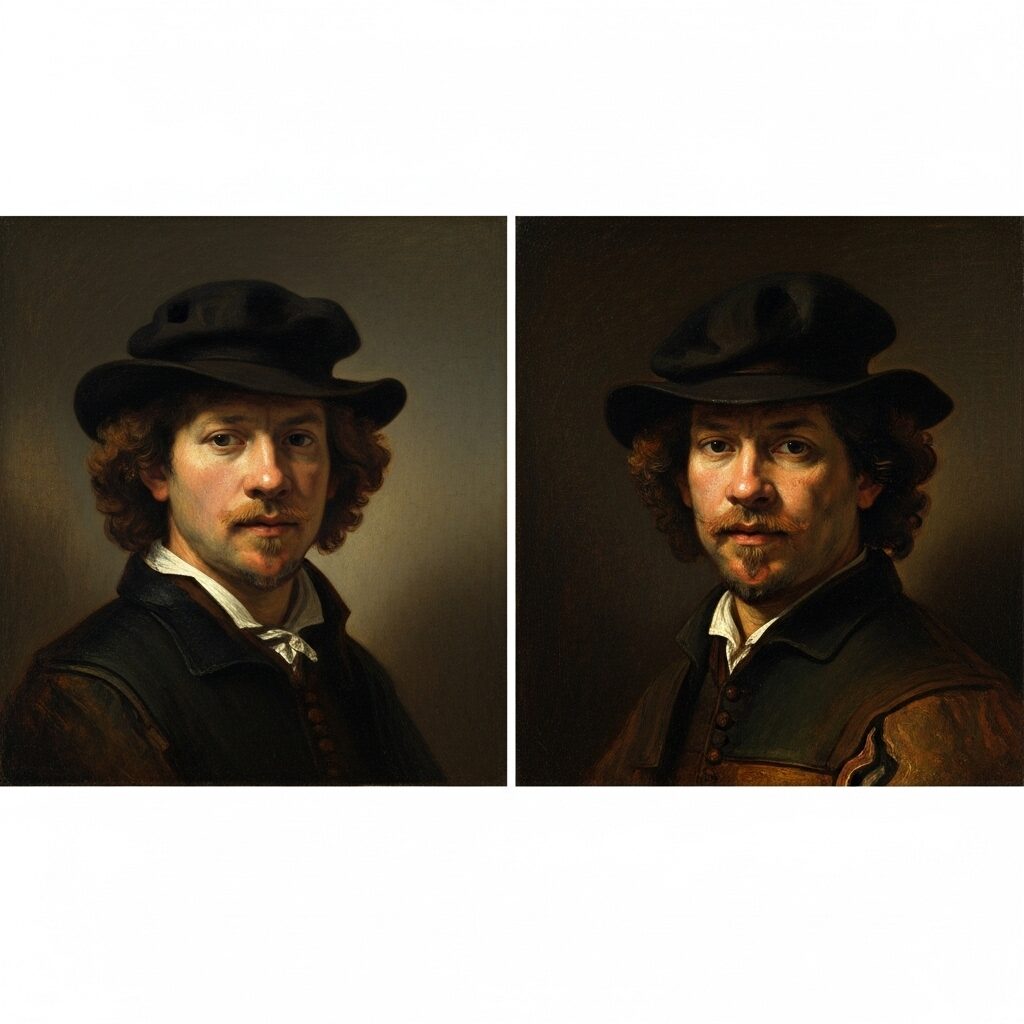
Rembrandt’s self-portraits show how Tenebrism influenced later artists, though he used softer, more psychological lighting
Art historians mostly correlate the use of tenebrism with religion, but beyond religious purposes, Caravaggio was using tenebrism to meet the naturalism demands of his time. The technique had several major impacts:
Counter-Reformation Art: The Catholic Church embraced tenebrism because it made religious scenes feel immediate and emotionally powerful, helping to reconnect people with their faith.
Influence on Later Masters: While Rembrandt wasn’t technically a tenebrist, he learned from Caravaggio’s innovations, using dramatic lighting to explore psychological depth in his portraits.
Modern Visual Storytelling: The principles of tenebrism live on in film noir, photography, and even modern cinema, where dramatic lighting creates mood and focuses attention.
Spotting Tenebrism in Museums and Galleries
Next time you visit a museum, here’s how to identify tenebrist paintings:
- Look for the black: Is most of the background completely dark?
- Find the light source: Can you tell where the light is coming from?
- Check the drama: Does the lighting make you feel tension or excitement?
- Notice the focus: Are only certain parts of the painting illuminated?
- Feel the mood: Does the painting feel theatrical or mysterious?
If you can answer “yes” to most of these questions, you’re likely looking at a work influenced by tenebrism.
Tenebrism in Modern Times

While tenebrism reached its peak during the Baroque period, its influence continues today:
Photography: Portrait photographers use dramatic lighting to create mood and focus attention
Film: Directors use high-contrast lighting to create suspense and drama
Digital Art: Modern artists use digital tools to create tenebrist effects
Theater: Stage lighting often employs tenebrist principles to guide audience attention
The Psychology Behind Tenebrism
Why does tenebrism affect us so powerfully? The answer lies in how our brains process light and shadow:
- Attention: Our eyes naturally focus on the brightest areas of an image
- Emotion: Darkness creates mystery and tension, while light provides relief and revelation
- Storytelling: The contrast between light and dark mirrors the struggle between good and evil, knowledge and ignorance
- Memory: High-contrast images are more memorable than evenly lit ones
Learning from the Masters: Tenebrism Techniques
For aspiring artists interested in tenebrism:
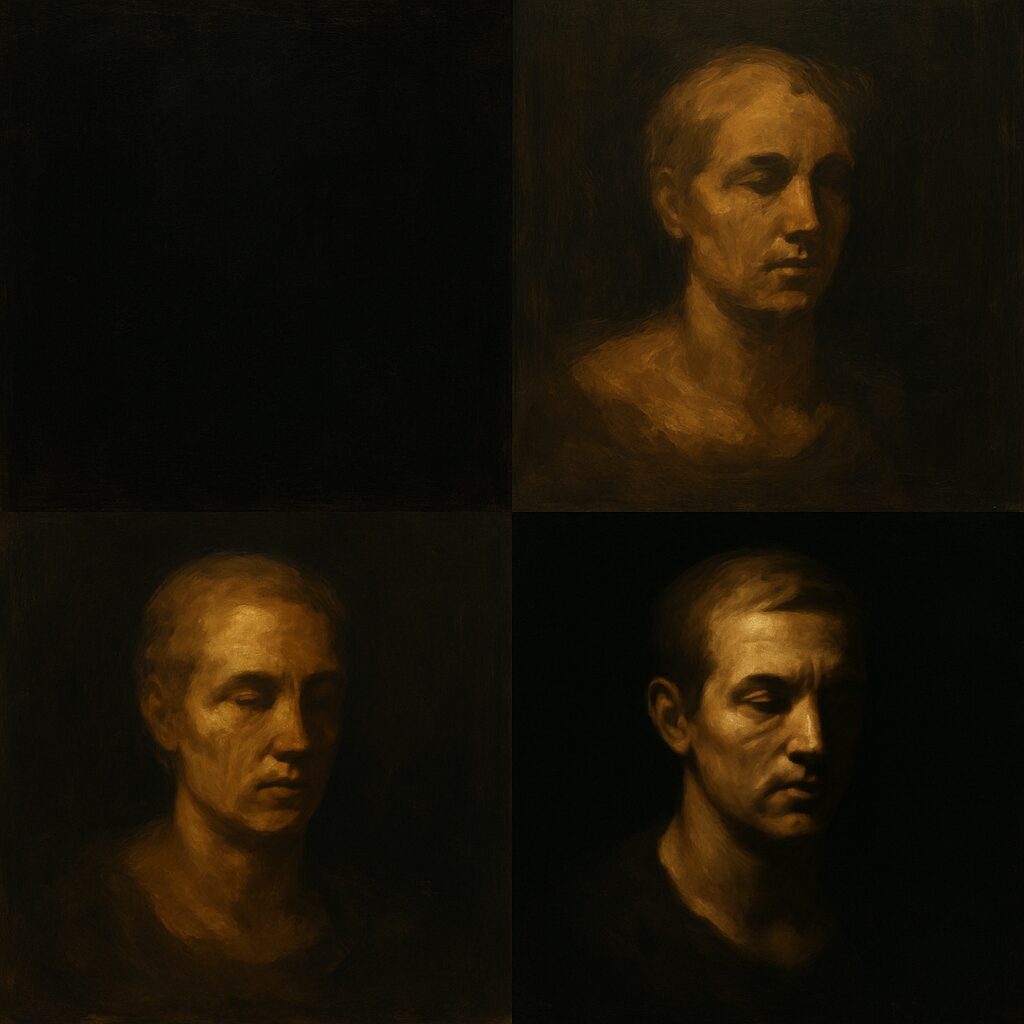
Start with the darkness: Paint your background dark first, then add light selectively
Use a single light source: This creates the most dramatic, unified effect
Study real light: Observe how actual light behaves in dark spaces
Focus on emotion: Use light to highlight the most important emotional moments
Practice selective illumination: Don’t light everything – choose what matters most
Famous Tenebrism Paintings You Should Know
Essential tenebrist masterpieces include:
- “The Calling of Saint Matthew” by Caravaggio (1599-1600)
- “Judith Slaying Holofernes” by Artemisia Gentileschi (1614-1620)
- “The Penitent Magdalene” by Georges de La Tour (1640-1645)
- “Saint Andrew” by Jusepe de Ribera (1630-1632)
- “The Incredulity of Saint Thomas” by Caravaggio (1601-1602)
FAQs: What is Tenebrism?
What is the main difference between Tenebrism and Chiaroscuro?
While both techniques use light and shadow, chiaroscuro creates realistic three-dimensional forms through gradual light transitions. Tenebrism uses extreme contrasts with darkness dominating the composition to create dramatic, theatrical effects.
Why did Caravaggio develop tenebrism?
Caravaggio developed tenebrism to create more emotionally engaging and realistic religious art. The technique helped him break from idealized Renaissance styles and show biblical figures as real, relatable people experiencing profound moments.
Is tenebrism still used today?
Yes, tenebrism principles are widely used in modern photography, film, and digital art. The technique’s ability to create drama and focus attention makes it valuable for contemporary visual storytelling.
What does tenebrism mean in art?
Tenebrism refers to a painting technique that uses extreme contrasts between light and dark, with darkness dominating most of the composition. The term comes from the Italian “tenebroso,” meaning dark or gloomy.
How can I recognize tenebrism in paintings?
Look for paintings with mostly dark backgrounds, dramatic spotlight-like lighting, high emotional intensity, and selective illumination of only the most important elements. The overall effect should feel theatrical and mysterious.
Who were the most famous tenebrism artists?
The most famous tenebrist artists include Caravaggio (who invented the technique), Artemisia Gentileschi, Georges de La Tour, and Jusepe de Ribera. These artists mastered the dramatic use of light and shadow to create powerful emotional effects.
Tenebrism remains one of art history’s most powerful techniques, proving that sometimes the most dramatic effects come from what we choose to hide in shadow rather than reveal in light. From Caravaggio’s revolutionary canvases to modern photography and film, this dramatic interplay between light and dark continues to captivate viewers and tell stories that resonate across centuries. Whether you’re an art student, museum visitor, or simply someone who appreciates visual drama, understanding tenebrism opens up a new way of seeing how artists use light not just to illuminate, but to move, inspire, and transform.
Additional Resources
- The Metropolitan Museum of Art – Caravaggio search results: https://www.metmuseum.org/search-results?q=caravaggiometmuseum
- Art History II – Caravaggio and His Followers: https://stevala.pressbooks.sunycreate.cloud/chapter/caravaggio-and-his-followers/stevala.pressbooks.sunycreate
- National Gallery London – Tenebrism Glossary: https://www.nationalgallery.org.uk/paintings/glossary/tenebrismwikipedia
- YouTube – Tenebrism Explained: https://www.youtube.com/watch?v=cjfgUn2E17kyoutube
- Britannica Encyclopedia – Tenebrism: https://www.britannica.com/art/tenebrismbritannica
- Merriam-Webster – Tenebrism definition: https://www.merriam-webster.com/dictionary/tenebrismmerriam-webster
- Mastering Tenebrism: A Painter’s Guide – Number Analytics: https://www.numberanalytics.com/blog/ultimate-guide-to-tenebrism-in-painting-stylesnumberanalytics
- DailyArt Magazine – Tenebrism 101: https://www.dailyartmagazine.com/tenebrism-101/dailyartmagazine
- Caravaggio Paintings at The Getty: https://davidgev.com/my-blog/caravaggio-paintings-getty/davidgev
- YouTube – Getty Caravaggio Overview: https://www.youtube.com/watch?v=CqfHNi8HptQyoutube
- MasterClass – Tenebrism in Art Explained: https://www.masterclass.com/articles/tenebrism-art-guidemasterclass
- Ultimate Guide to Tenebrism – Number Analytics: https://www.numberanalytics.com/blog/ultimate-guide-to-tenebrism-drama-in-art-historynumberanalytics

